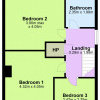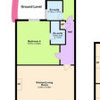Underfloor Heating - Low Profile System or Mixed?
Hi Houzzers,
I'm in the middle of building a 6m single storey extension to my house. This will create one large open plan area of 80m2 downstairs in which I intend to install UFH. This will be tiled with some lovely scandi wood effect porcelain tiles to maximise heat output, whilst retaining the design style I like.
I'm trying to figure out the best way to run UFH through the property. The problem is that the ceiling height in the original house is only 2.3m, so I really can't afford to lose too much height. These are my options as far as I can see:
- A low profile system using a board like this kit here This will add 15mm to the height, and I can tile directly on to the board. This is the easiest and most obvious. However, the cost is circa £4,200.
- A cheaper kit such as this which includes a different type of backing board. This one will require a self-levelling compound on top of the board before the tiles can be laid, so the total cost is circa £3,500 even though the kit looks like it's only £2k-ish.
- Dig up the pre-existing screed in the old house and lay a normal UFH system like this before re-screeding. Cost is just under £1k for the system, plus the cost of removing and re-laying the screed. This is almost certainly a silly option, but putting in here for comparison.
The problem I have is that the cost difference is insane between laying UFH in a new build screed, and retrofitting. For all you expert Houzzers out there who know about UFH:
- Is it possible to run a mixed system? So for the extension it's a standard UFH kit with 16mm pipes set into the screed, whilst the old part of the house runs on a low profile kit. There are some savings to be had this way.
- Are there any low profile kits out there which (i) include a backing board which can be tiled directly onto without levelling compound and (ii) are cheaper than £4k?
- Any other recommendations for this type of build? The old part of the house is becoming a kitchen, whilst the new part is living/dining.
Thanks guys, any advice would be very much appreciated!
Dom
Comments (10)
Rowland
3 years agoHi Dominic,
I think you can install ufh to both areas. if you are laying UFH in the new extension you will need to have the insulation within the ground slab to comply with Building regs. The hearing pipes will e run to a manifold that controls the zones that are created. based on the size of the floor area you quoted you will probably have 3 or four zones linked to provide an even heat to the area.
the remaining areas of your home can have a different system provided- there are options that can be run under existing floor boards on a preformed plate system that will avoid a loss in ceiling height.
if you check the Rehau UFH system it can provide both of the types of system. there are many cheaper options for the UFH, but if you start with this manufacturer you can then see the others having compared a high end system with the others on the market. they have a very comprehensive information available online and you can check to ensure you choose the system that works.
best
Rowland
Dominic 88 thanked RowlandR.H.Mawdsley LTD
3 years agoHi Dom, I did this in my current house. The floor area of the existing house was 75m and I added a 75m extension. I used a polypipe retrofit system in the existing part of the property like you described in your first option and then used a traditional method of pipe in screed for the extension. I just worked my levels so the finished screed height was the same as the top of The retro fit tiles that the pipe sits in. You will require 2 manifolds to run the 2 separate systems. I emailed over my floor plan to a polypipe rep, highlighting the areas which would be retro fit and which would be in screed with my proposed locations for the manifolds. They produced me a Design, kit list and price (expensive), which I then sent to a local supplier of polypipe kit who were much cheaper.
R.H.Mawdsley LTD
3 years ago

sorry I can’t find any better pictures but you can just about see the transition from retro fit boards through to the screed. Rob.Dominic 88 thanked R.H.Mawdsley LTDDominic 88
Original Author3 years agoThis is super helpful, thanks Rob! Did you find a difference in performance between the two zones?
HU-917967737
3 years agoI would love to know the answer too. Am thinking of a retro fit system and researching them at present.
Dominic 88
Original Author3 years agoIf it helps, I'm planning on a low profile system for the entire floor now. After speaking to a few companies, it seems that the difference in heating times for two separate types of systems in the same room may make temperature control a little tricky. I'm sure it can be done, but I'm going to keep it simple.
Rowland
3 years agohi Dom,
the benefit of starting with a new subfloor allows for better levels insulation to be installed. this will provide you with a more efficient system with lower running costs. the payback on the installation can be significantly quicker with good insulation under your floor that prevents heat going downwards and being lost heating the land beneath the house.
obviously you have to weigh up costs on the systems with your budget. Be sure to check on running with a reduced sized pipe. if your overall system is old you could have problems in the future with the smaller pipes blocking with sludge.
make sure you are comfortable with what is being installed. remember "buy cheap buy twice" it is something you must weigh in you final choice.
best
Rowland
R.H.Mawdsley LTD
3 years agoHi, sorry it’s taken so long to reply. I think the retro fit system and new system split works great. No issue with warmth. No insulation under the retro fit boards but did improve the insulation in the walls and ceiling.
As rowland said ideally you start with a new subfloor BUT you have to factor in the cost of breaking out your existing floor, reducing your levels, pouring your sub base slab, the cost of your insulation, cost of your screed. It would take you 50 years to recoup that cost with what you’d save on running costs. My retro fit side of the system has no problem in heating the space. Dominic, I’m sure there is a performance difference but I find it had to tell (which I suppose is a good thing).HU-448940580
2 years agoWe are trying to change the carpet flooring ( approx 110sq m ) to the ground floor in our house. It is a 17y old property. We would like to have UFH- looks like the low profile system will be better in terms of not excavating the floors and not gaining much floor height. Will the low profile heating system be enough to warm the rooms or will we have to retain the radiators? Thank you

Reload the page to not see this specific ad anymore




R.H.Mawdsley LTD